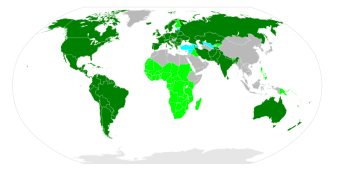This recent BBC article highlights the work of Kiwi researcher Dr. Quentin Atkinson on the origin of Indoeuropean. This is a language that we actually know very little about but many of the world’s major languages are derived from it (see the map below). The green countries mainly speak languages that descend from Indoeuropean, the neon green ones have an Indoeuropean language as their official language (or an official language) but actually have multilingual societies, and the turquoise ones have large minorities that speak an Indoeuropean language.
My friend Vlad (over at Forever a Student) has been attempting to learn Persian/Farsi. He speaks eleven languages, some of them with a near native level of mastery. Most of his languages are Indoeuropean: English, Italian, Slovak, French, Russian, German, Czech, Spanish, German and Portuguese. He also speaks two that are not Indoeuropean quite well (Mandarin Chinese and Hungarian). The man can’t help but be a philologist! Here are some examples of connections that he’s made between his different Indoeuropean languages and his newest Indoeuropean language: Persian.
Vlad:
Apart from the most obvious ones like bad (bad), tche (che), barâdar (brother), nou (new) and others, there are also a few mind blowing vocabulary relation to Slavic languages:
vopors – to ask (Rus vopros – question, Svk prosiť – to ask)
Hast – there is, il y a, es gibt
There are a lot of other cognates as well, but they are obviously much younger:
garson – boy
Dr. Atkinson applied technology that shows the level of commonality in the DNA in different organisms to languages. This apparently was done with a huge data base of cognates. His results led him to believe that Indoeurpean does not come from the Caucuses but from Turkey.
What do you think of this idea? Do languages change the same way that organisms evolve? Does it matter where Indoeuropean originated?
Filed under: Languages |




Well of course it matters, from an anthropological point of view as well as a linguistic one and a historical one. There are a lot of academic fields that will be affected by this.
I definitely think there’s some sort of evolution to languages even if it’s not perfectly identical in nature to that of organisms, there’s definitely a sort of natural selection based on utility that occurs where the most useful ones spread like wildfire and the least useful ones die out.
Fascinating article and analysis, Ryan, thanks for sharing.
Cheers,
Andrew
Great points as always Andrew!
[…] vocabulary… What to Expect at a Deposition: Part 2 Upcoming Literary Translation Events English Comes from Turkey: Part I What exactly is corpus linguistics? Interesting facts about language How language change sneaks in […]
Thanks, Ryan. I especially like the Farsi comments, since I’m learning Farsi.
Since I learned Arabic before, Farsi vocab is a lot easier. I found that I can even say Arabic words with a Farsi accent and people can often understand. It’s funny. I was hoping this would work with Somali, but not so much.
Regarding evolution, I’d like to bring up another point. Languages don’t evolve in a vacuum but in an ecosystem. For example, Farsi borrowed a lot of words from Arabic. At the same time, Arabic has borrowed many Persian words. In addition, Iraqi Arabic pronounces the “k” as a “ch” as in many Persian dialects. The first person singular pronoun in Arabic is “aani” has the distinctive rounded “aa” that you find in Farsi. (For what it’s worth, the same pronoun in Hebrew is “ani,” so maybe the similarity goes back farther.)
A friend of mine, now in his 80s, wrote a definitive work on the areal language relations in India. This is a very interesting idea, which shows the interactions between “environmental” and “genetic” aspects of language.
Good food for thought Rich, as always. I definitely see how the evolution of species and the way in which languages change over time have some real similarities. I also think there is at least one very important difference that has to do with animal instinct.
Haven’t heard from you in a while. Hope you’re doing well and I look forward to the next post!
[…] English Comes from Turkey: Part I […]
Very interesting! I found your website somewhere over a friend’s wall on Facebook, and I can’t help but to read more of your blog. Keep up the good work my friend!
I’m glad you like it Rémi! I hope you keep coming back.
This is very nice. I saw your site through foreverastudent.com and glad I found it. Definitely will bookmark this blog to follow it. Thanks!